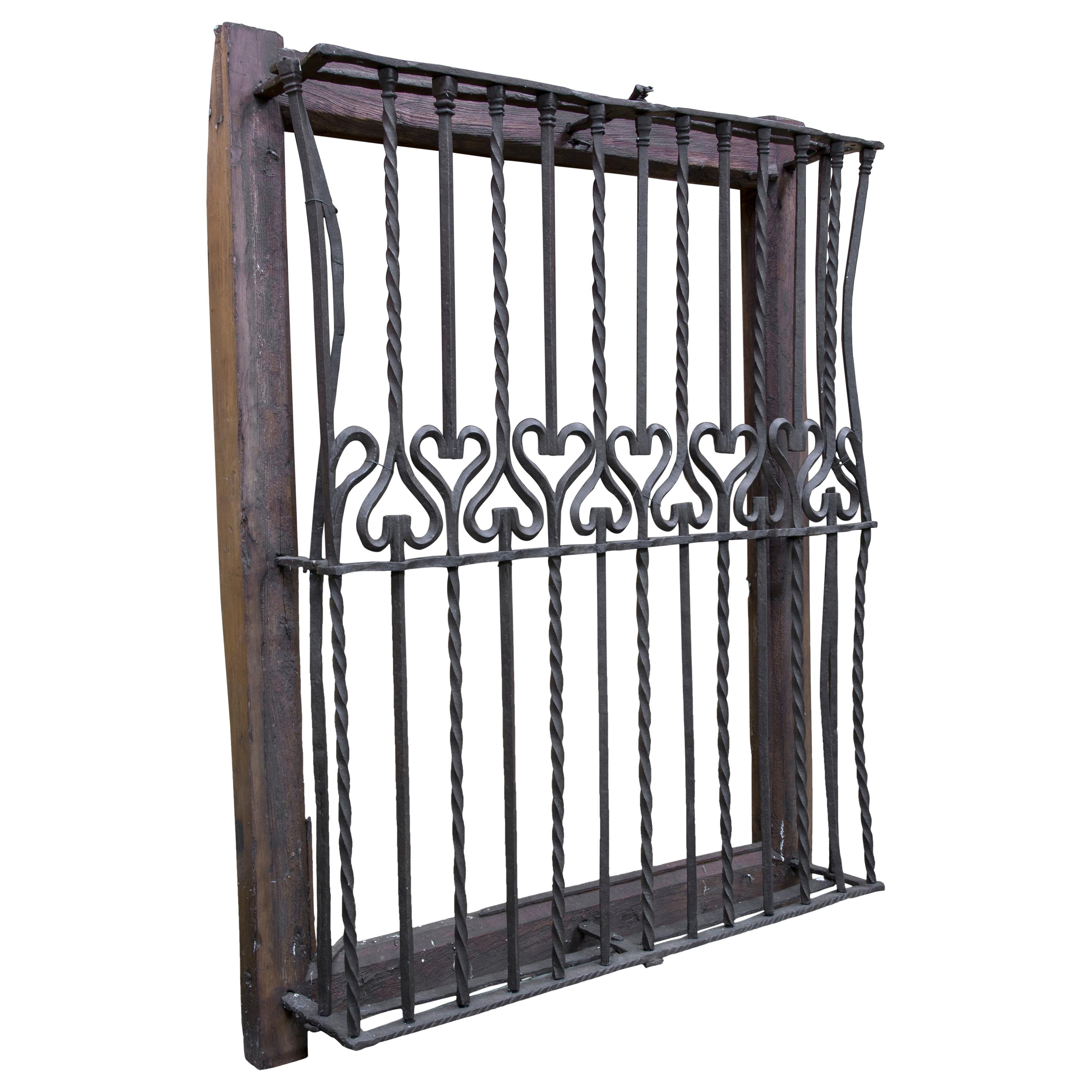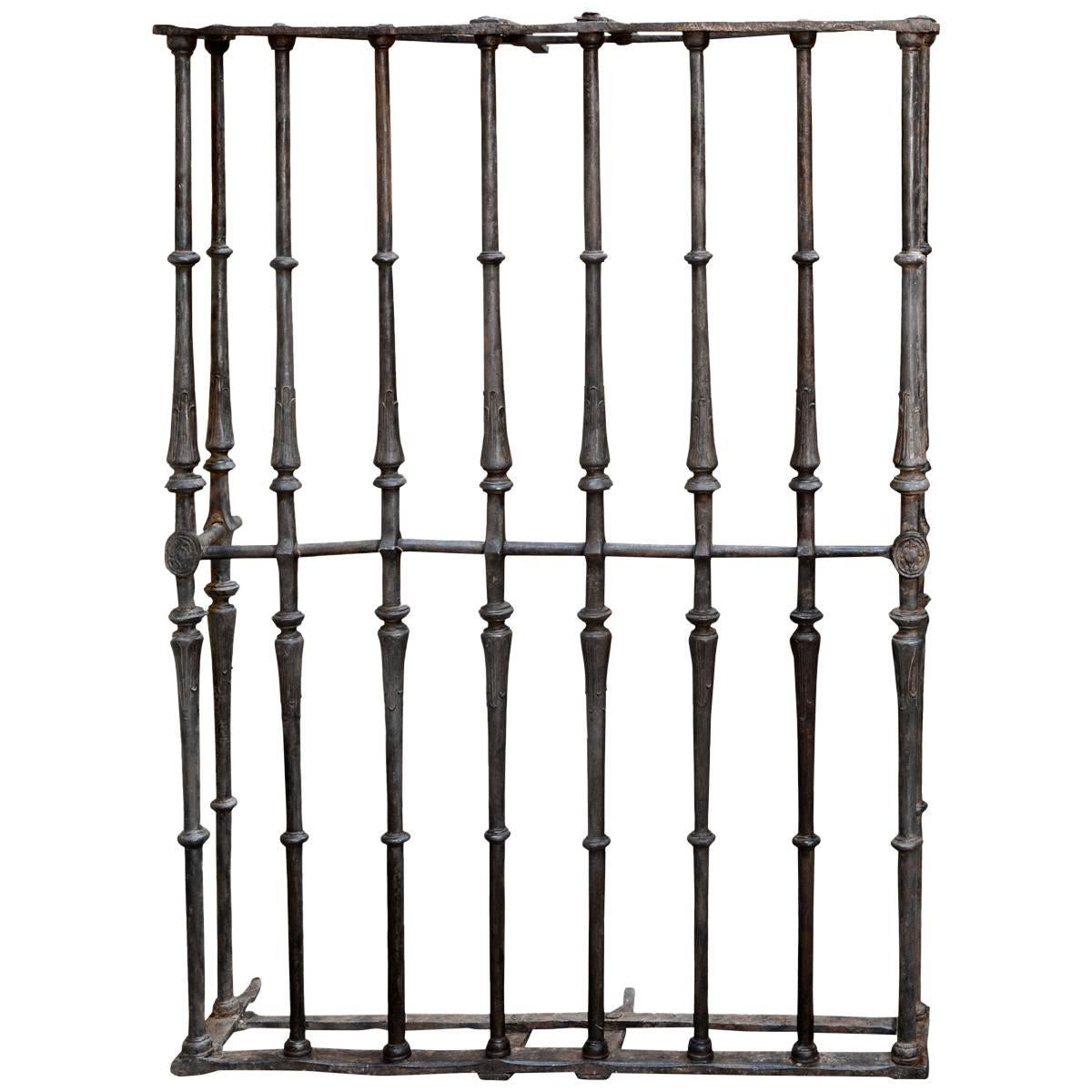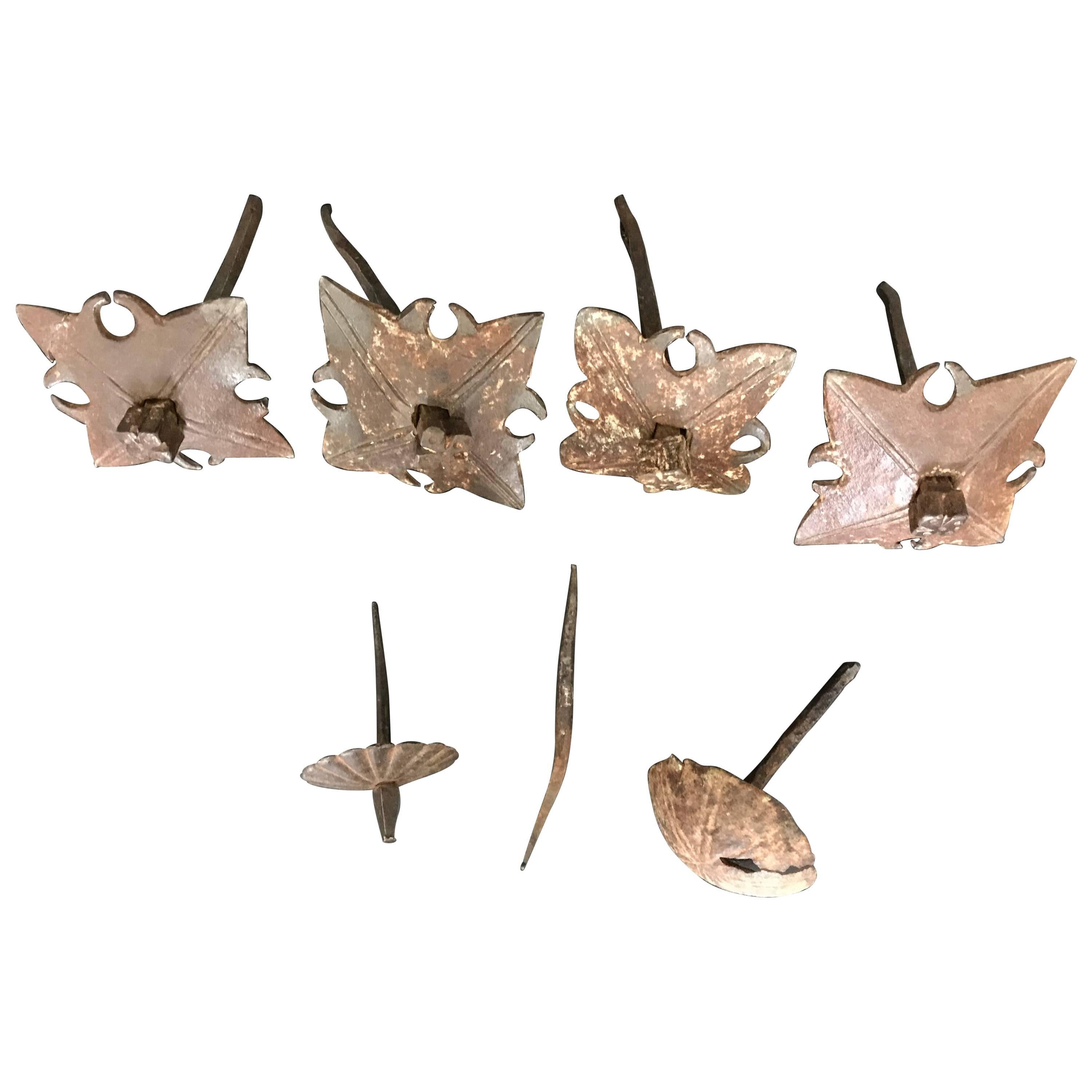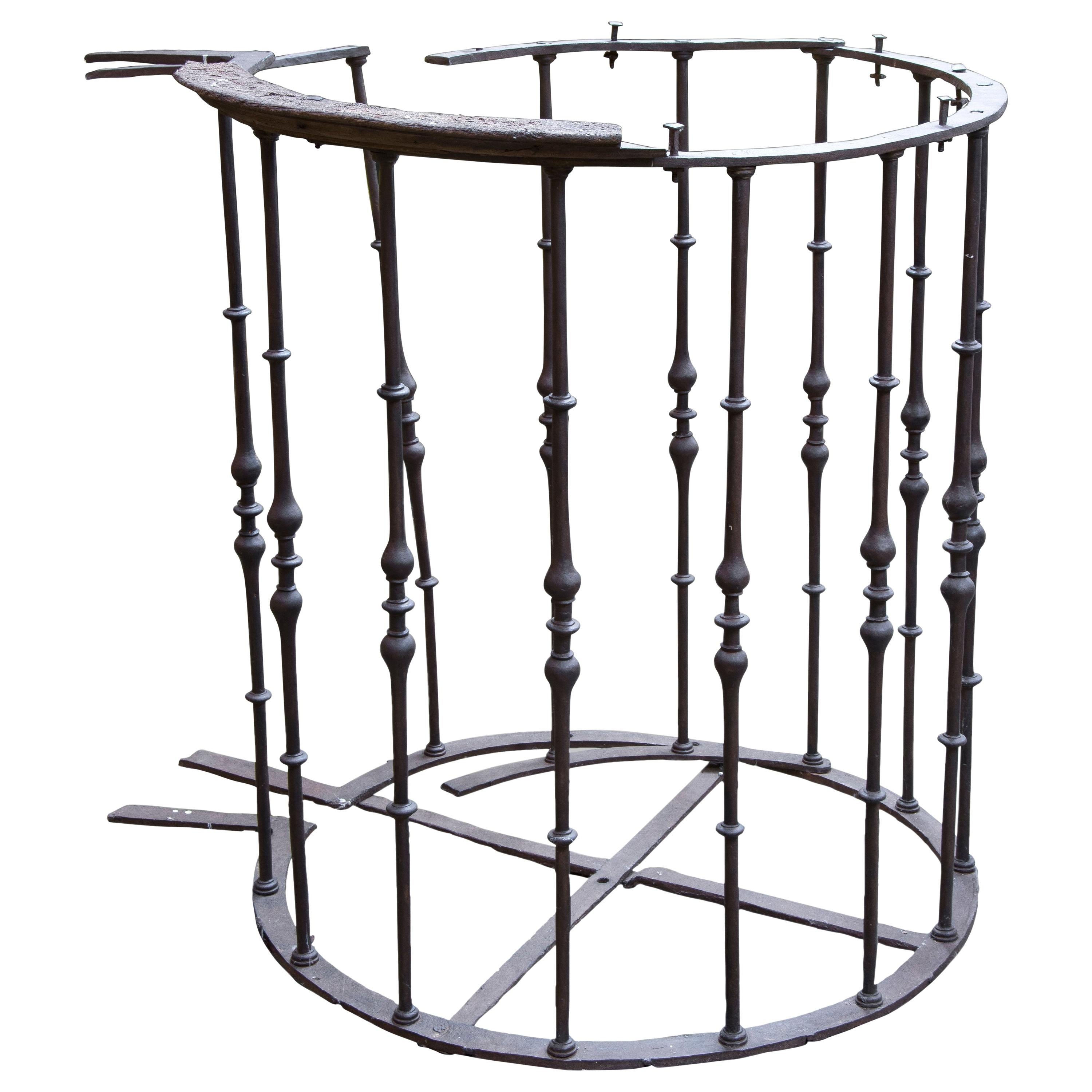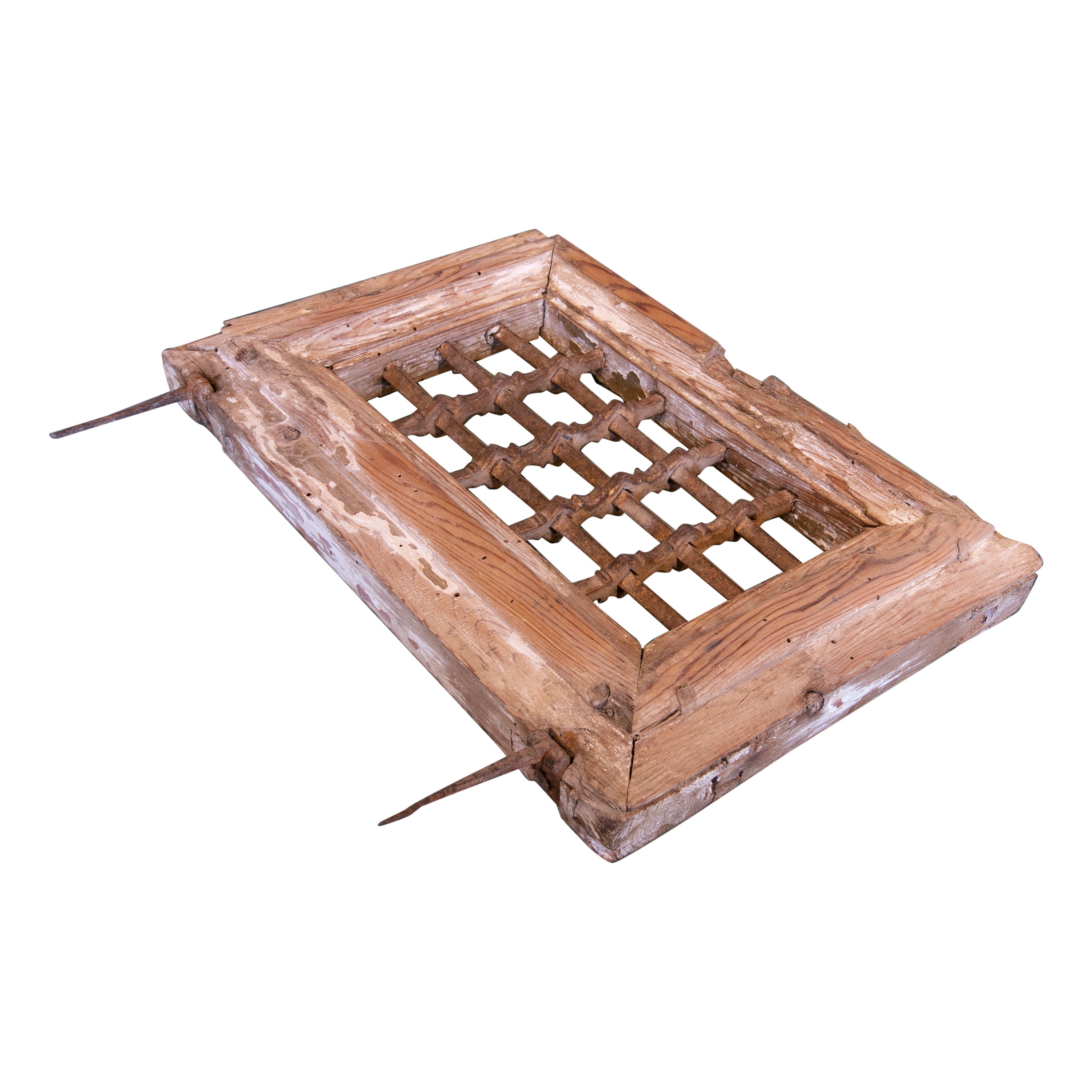Items Similar to Renaissance Grille, Wrought and Gilt Iron, Stone, Spain, 16th Century
Want more images or videos?
Request additional images or videos from the seller
1 of 7
Renaissance Grille, Wrought and Gilt Iron, Stone, Spain, 16th Century
About the Item
Chapel grille with two fixed leaves at the sides, and double opening leaf in the center, topped with an elaborate crest, all made of wrought and "blued" iron, creating a polychrome preserved in good condition. The bars of the lateral zones, tubular, are decorated with discs of the same diameter. The double door of the center presents bars ballasted to the center flanking a disc and other similar disks up and down; in the lower area, there is a frieze with two opposing "ces" accompanied by simplified plant elements that draw volutes towards the sides; note the small wheels at the bottom of the grid. The crest presents an oval shield with the cross of the Order of Calatrava, enhanced with architectural elements and flanked by vegetal "S-shapped" motifs, accompanied by leaves; to the sides of this central piece appear two columns of ajarronado shaft enhanced with "C-shapped-forms" and "S-shapped-forms" drawn in their shafts.
In general terms, there is talk of a division in two stages in terms of Antique grills is concerned, highlighting in any case the high quality of Spanish works of the time both for the number of works and their quality in materials and design. The "grilel Art" of the Spanish Plateresque style repeated elements of the Gothic period, transforming the bars of cylindrical or square section into balusters and recharging the friezes, finials and crests, elements made following the Renaissance style (with preference in the inspiration of Rafael's grotesques of Urbino), and using gold, silver and blue. The second stage, sometimes called Greco-Roman, centered towards the second half of the 16th century, shows more massive and rounded forms that are usual in "classicism", although there are some masters who maintain previous details.
In spite of being frequent elements in the houses and other outstanding buildings, they have not conserved copies in good state of conservation in a very abundant number. Compare this example with the Reja of the Palacio de los Cárdenas, dated in 1575 (from the Palace of the Count of La Quintería de Andújar, Jaén, today in the National Archaeological Museum of Madrid), the grills of the Cathedral of Orihuela attributed to Jerónimo Quijano (1,500-Murcia, 1563) by some experts, the gate of the Chapel of the Annunciation or Hernán López of the parish church of Santa María Magdalena de Torrelaguna in Madrid (dated in the last quarter of the 16th century), gate of the Chapel of San Pedro in the Cathedral of Valladolid, etc.
Size: Stones: 79 cm (base); 95 cm (high) (each). Doors: 130 cm (base), 230 cm (high) (each). Crown: 349 cm (base), 165 cm (high). Lateral grilles: 80 cm approx. (base), 135 cm (high) (each). Total (aprox): 400 cm (base), 395 cm (high). Depth is orientative.
I
- Dimensions:Height: 155.52 in (395 cm)Width: 157.49 in (400 cm)Depth: 7.88 in (20 cm)
- Style:Renaissance (Of the Period)
- Materials and Techniques:
- Place of Origin:
- Period:
- Date of Manufacture:16th Century
- Condition:Wear consistent with age and use. Minor losses.
- Seller Location:Madrid, ES
- Reference Number:
About the Seller
4.9
Vetted Seller
These experienced sellers undergo a comprehensive evaluation by our team of in-house experts.
Established in 1985
1stDibs seller since 2017
292 sales on 1stDibs
Typical response time: 21 hours
- ShippingRetrieving quote...Ships From: Madrid, Spain
- Return PolicyThis item cannot be returned.
More From This SellerView All
- Wrought Iron Grille, 16th CenturyLocated in Madrid, ESA carved wooden frame serves as a support for the wrought iron grille that has decorated balusters: all have a heart-shaped form in the centre, whi...Category
Antique 16th Century Spanish Renaissance Architectural Elements
MaterialsWrought Iron
- Wrought Iron Grille, Spain, 16th CenturyLocated in Madrid, ESTypologically, it is a partial architectural grating with an ornamental and defensive purpose at the same time. Likewise, it clearly shows some of the striking decorative and typolog...Category
Antique 16th Century Spanish Renaissance Religious Items
MaterialsWrought Iron
- Wrought Iron Grille, Spain, 17th CenturyLocated in Madrid, ESWrought iron grating with ten vertical double-pearl bars decorated with small discs and other simpler verticals (up and down planes, the central tubular and inserted through the vert...Category
Antique 17th Century Spanish Baroque Architectural Elements
MaterialsWrought Iron
- Wrought Iron Grille, Spain, 17th CenturyLocated in Madrid, ESWrought iron window grille that has two horizontal bars in the middle, inserted between the vertical bars. These present a decoration of small discs...Category
Antique 17th Century Spanish Baroque Architectural Elements
MaterialsWrought Iron
- Wrought Iron Pulpit Grille, 18th CenturyLocated in Madrid, ESWrought iron grating with thirteen bars with double pear and discs in their shafts, arranged in a circle with bars of the same flat material (circular and cross combined at the base ...Category
Antique 18th Century European Neoclassical Architectural Elements
MaterialsWrought Iron
- Frieze, Polychromed Pine Wood, 16th CenturyLocated in Madrid, ESRectangular frieze in carved pine wood, gilded and polychrome decorated with figurative reliefs. An architectural piece with garland serves as the axis for the symmetrical compositio...Category
Antique 16th Century European Renaissance Architectural Elements
MaterialsPine
You May Also Like
- 16th Century Spanish or Italian Baroque Wrought Iron Nails and Furniture MountsLocated in Stamford, CTGroup of 16th century (or earlier, possibly Gothic) Spanish or Italian wrought iron furniture mounts. These hand-wrought bosses and nails show incredible workmanship. These would have been used to decorate - and to structurally hold together an early chest or casket. The four geometric bosses beautifully made, eight ounces each without the nail! The nails are works of art in themselves, with their heavy geometric heads. Also two round bosses with the nail integral to the piece, one a mushroom form, the other like a parasol. And a single hand-wrought double sided nail. Great group of early iron. Provenance: Frances Pratt, Writer, Artist, Collector. New York City. Approximate sizes: 4 bosses 4.625 inches square 11.75 cm Round bosses 3 inches diameter the larger 2.5 the smaller 7.6/ 6.35 cm 4.5 in high 11.4 cm 5 nails...Category
Antique 16th Century Italian Baroque Architectural Elements
MaterialsIron
- 16th Century Spanish Iron Window with a Wooden FrameLocated in Marbella, ES16th Century Spanish iron window with a wooden frame.Category
Late 20th Century Spanish Architectural Elements
MaterialsIron
- 17th Century Spanish Wrought Iron Grille on Rosa Marble BaseLocated in Marbella, ES17th century Spanish wrought iron grille on Rosa marble base. Grille dimensions: 195 x 186 x 4.5cm Marble base dimensions: 43 x 190 x 27cm.Category
Antique 18th Century Spanish Balustrades and Fixtures
MaterialsMarble, Iron
- Venetian 16th Century WellheadLocated in Zedelgem, BE16th century wellhead from Venice, rare find, museum quality that needs a bit of restoration, done by us. The stone it's made out is Italian Pietra Serena.Category
Antique 17th Century Italian Renaissance Architectural Elements
MaterialsLimestone
- 19th Century Spanish Andalusian Double Door with Wrought Iron Decorative GrilleLocated in Marbella, ESAntique 19th century Spanish Andalusian two panel double door with wrought iron decorative grille atop. Dimensions correspond to each door panel. ...Category
Antique 19th Century European Doors and Gates
MaterialsWood
- Spanish 16th Century High Relief Limestone Bust from a BuildingLocated in Marbella, ES16th century high relief limestone bust that topped a stone arch. Side heraldic decorations indicate a patron Saint. The face is weathered but the general condition is good.Category
Antique 16th Century Spanish Renaissance Architectural Elements
MaterialsLimestone
Recently Viewed
View AllMore Ways To Browse
Material Architecture
Architecture House Design
Spanish Architecture
Spain Architectural
Antique 16th
16th Century Antiques
Spain Building Elements
Stone By The Door
The Stone By The Door
Antique Blue Stone
Roman Architecture
Architectural Antique House
Small Renaissance
Stone Decorated Furniture
Wrought Gilt Iron
Architectural Cross
Spanish Wrought Iron
Church Architecture
